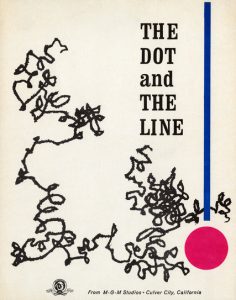 By 1965, the submissions to the Academy’s short branch were clearly more sophisticated than ever before. A new maturity of the artform had been established – no TV cartoons or pilots were entered for consideration. This year also marked an increase in the actual number of short films submitted – and the quality all-around was quite high. The independent and foreign shorts were also becoming something to be reckoned with. In the meantime, Freleng (last year) and Jones (this year) were maintaining the gold standard for the Hollywood home team.
By 1965, the submissions to the Academy’s short branch were clearly more sophisticated than ever before. A new maturity of the artform had been established – no TV cartoons or pilots were entered for consideration. This year also marked an increase in the actual number of short films submitted – and the quality all-around was quite high. The independent and foreign shorts were also becoming something to be reckoned with. In the meantime, Freleng (last year) and Jones (this year) were maintaining the gold standard for the Hollywood home team.
The Dot and The Line was the latest – perhaps the best – and absolutely the last of Chuck Jones’ artistic exercises. It was truly deserving of the Oscar – and masterfully combined Jones love of witty writing with clever use of limited animation. It proved that great character animation could be achieved with the simplest of shapes – and in pantomime (all the dialogue is via superb narration by Robert Morley). I’ve come to admire the production design in this film by Maurice Noble (who officially shares the ‘co-director’ credit here), subtle and very effective. I can’t imagine any other team bringing this short story to life with such class.
This week: 1965
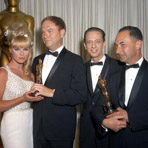 The actual nominees were:
The actual nominees were:
CLAY OR THE ORIGIN OF THE SPECIES Eli Noyes [View]
THE THIEVING MAGPIE Giulio Gianini-Emanuele Luzzati [View]
And the Oscar went to:
THE DOT AND THE LINE (MGM) Chuck Jones, director. [View]
On April 18th, 1966 at the Santa Monica Civic Auditorium, presenters Elke Sommer and Don Knotts presented the Oscar to producer Les Goldman and director Chuck Jones. Here’s a video of that presentation:
CHUCK JONES:
A great deal has been said in favor of the idea that films are bigger than ever; we feel that occasionally some word can be said for films being smaller than ever. Norton Juster’s book, “The Dot and the Line,” we felt was a delightful, small book, and I’d like to particularly thank those people who, against all temptations, fought to keep it small: To Maurice Noble, to Eugene Poddany, and of all things to Robert Morley. Thank you very much.
LES GOLDMAN:
It’s a rare and privileged time when a major studio goes way out and backs a strange and wild entertainment film like “The Dot and the Line.” And I want to thank the MGM management for being with us all the way, and, of course, all the members of the Academy. Thank you.
And so we continue our weekly research into what other cartoons were submitted to the Academy for Oscar consideration but failed to make the cut. In 1965, there were a lot of entries. Submitted, screened, but NOT nominated were:
 “A” (Pathe Contemporary) Jan Lenica
“A” (Pathe Contemporary) Jan Lenica
ALF, BILL AND FRED Bob Godfrey
BOILED EGG (Pathe Contemporary) Marc Andrieux, Barnard Brevent
A CHILD’S INTRODUCTION TO THE COSMOS (USC) Hal Barwood
CLAUDE (UCLA) Dan McLaughlin
DRESS REVERSAL (20th Century Fox-Terrytoons) Ralph Bakshi
DRIVE ON NUDNIK (Rembrandt-Paramount) Gene Deitch
ENTER HAMLET (Pathe Contemporary) Fred Mogubgub
THE GREAT DEGAULLE STONE OPERATION (UA/DePatie-Freleng) Friz Freleng, Gerry Chiniquy
THE HOFFNUNG SYMPHONY ORCHESTRA (Halas and Batchelor) Harold Whitaker
HOW TO LIVE WITH A NEUROTIC DOG (Rembrandt-Paramount) Gene Deitch
HOWARD (Stars and Stripes Forever Productions) Len Glasser
THE ITCH (Paramount) Howard Post
A LEAK IN THE DIKE (Paramount) Jack Mendelsohn, Howard Post
THE NOSE (Pathe Contemporary) Alexander Alexieff, Claire Parker
THE TOP (Pathe Contemporary) Jimmy Murakami
THE WILD CHASE (Warner Bros.) Hawley Pratt
WINNIE THE POOH AND THE HONEY TREE (Disney) Wolfgang Reitherman
WOOF-WOOF (Zagreb Studios) Boris Kolar
CARNIVAL – THE WORLD OF SINE (Specta Films) Jules Engel
Here’s the documentation (Note that Assault And Peppered, a mediocre McKimson Speedy and Daffy cartoon, is crossed off as ‘withdrawn’):
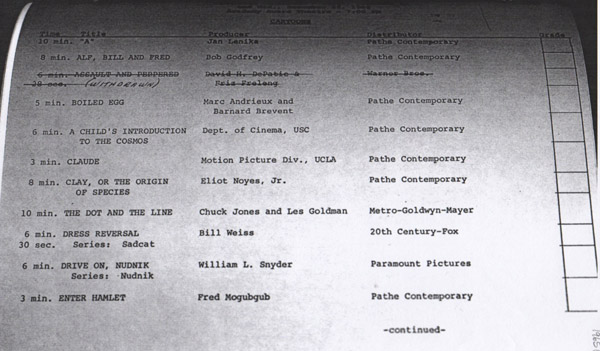

With these posts we ask that you put yourself in their place – which films would you have nominated? Which cartoon should have won? For your edification and viewing pleasure, here are the cartoons the Academy screened which didn’t make the cut (unfortunately not all of them are online – and with so many entered, my comments this week will be brief). Enjoy the show!
“A” (Pathe Contemporary) Jan Lenica
A man in his apartment is antagonized by a large letter “A”. After being beaten into submission, the letter ‘A’ leaves. The man starts his daily routine again – only to be visited by an ominous letter “B”.
A pen-and-ink style recalling 19th Century engraving, supposedly inspired (or written, uncredited) by avant-garde playwright Eugne Ionesco, “the letter symbolizes invasion of privacy, oppression or one’s own problem.” Interesting to note the music was scored by French film composer Georges Delerue – who gained much fame for his later feature scores (for King of Hearts and Platoon among others).
ALF, BILL AND FRED Bob Godfrey
I haven’t seen this one – but this is a little fable about a man (Bill), a dog (Fred) and a duck (Alf) who enjoy bouncing together. When Bill comes into an inheritance he buys everything he wants and squanders his money. At one point he bounces into a hot dog stand, crashing and losing his memory. Alf and Fred save him – and they end up opening an agency to sell “happiness”. The moral of the story: “It’s easier to sell happiness than to buy it.”
It’s told without dialogue, with occasional inter-titles. David Carins at Shadowplay.com says, “Its a simple, even twee, rags-to-riches type story, enlivened by a disrespectful approach to style and production values Godfrey creates a style by ignoring or celebrating the clashes of mixed media, and doesnt bother about things looking cheap.”
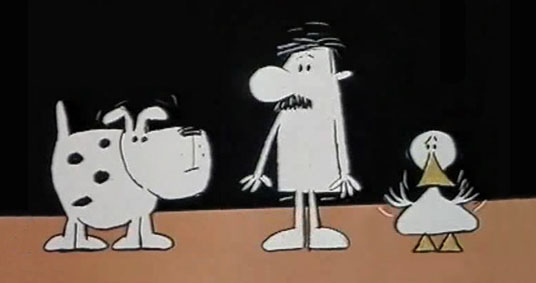
BOILED EGG (Pathe Contemporary) Marc Andrieux, Barnard Brevent
L’oeuf à la coque was produced in 1963, but submitted this year. No video available. Apparently it’s about the misadventures of “an apparently tipsy and over-confident boiled egg”.
A CHILD’S INTRODUCTION TO THE COSMOS (USC) Hal Barwood
Boy, I also have nothing on this film – other than it was written and directed by USC student Hal Barwood. This film won several awards, and Barwood himself went on to become a major Hollywood screenwriter (The Sugarland Express, MacArthur, Dragonslayer), and Lucasfilm video game creator (Indiana Jones and The Fate of Atlantis, Star Wars: Yoda Stories). If anyone locates a copy, let me know!
CLAUDE (UCLA) Dan McLaughlin
Claude is a cute 3-minute UCLA student film – made by future head-of-UCLA-Animation-Worksop, Professor Dan McLaughlin.
Claude is a small and silent boy who carries around a box to which he keeps adding dials, antenna, etc. His parents are extremely rich, throughout the film Calude’s father keeps telling his son: “Claude, you’ll never amount to anything.” Mother several times exasperatedly asks him: “Can’t you do anything, Claude?”. Claude says nothing but, in the end, he has the last act: he twiddles the dials on his completed box and vaporizes both parents.
More about the late Dan McLaughlin and Claude, click here.
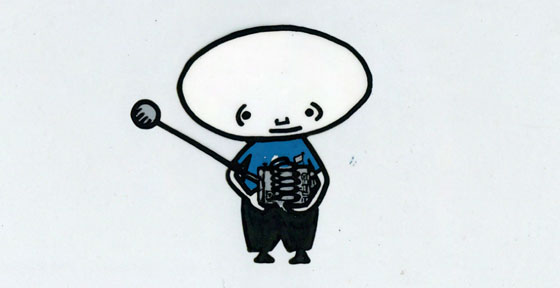
DRESS REVERSAL (20th Century Fox-Terrytoons) Ralph Bakshi
Another Ralph Bakshi Sad Cat cartoon; this one is not much different than the last – though perhaps a little sadder. This time Gadmouse (the apprentice good fairy) tries to help Sad Cat by giving him slick duds to join his brothers who are being judged as “the best dressed cats in the kingdom”. While en route to the fashion show, Sad Cat crashes into his mean brothers and all their clothes get mixed up. Next thing you know, Sad Cat’s new “beat” look wins first prize. Soon the entire kingdom wants “beat suits” – and Sad Cat has a future as a tailor, producing the suits – unfortunately under the supervision of his mean brothers.
DRIVE ON NUDNIK (Rembrandt-Paramount) Gene Deitch
Nudnik – who lives in a hole under a moving crane – emerges from his hole and goes about a typical day of everything going wrong. At one point, a bank robber accidentally thinks he hit Nudnik with his stolen car – and runs away from the scene of his “crime”. This leaves Nudnik in control of the car – or so he thinks. Everything goes wrong – from getting trapped in the seat cushions, to totaling the vehicle. In the end Nudnik gets arrested for car theft.
ENTER HAMLET (School Of Visual Arts) Fred Mogubgub
I’m a fan of Fred Mogubgub. I recall first seeing his name on a series of psychedelic full-tabloid-page drawings that graced the back cover of The East Village Other back in the late 60s. Always thought his funny name was a pseudonym (heck I thought “R. Crumb” was a pseudonym back then too). I later found out he was an avant grade artist and animator who had partnered with Pablo Ferro, made some of the coolest commercials in the 1960s, and later animated with R.O. Blechman.
Enter Hamlet is a little delight. You can tell he’s having a good time making this movie. I assume he was teaching at SVA went he produced this (he would would have been 38 in 1965). Maybe not a nominee – but it makes me smile.
THE GREAT DEGAULLE STONE OPERATION (UA/DePatie-Freleng) Friz Freleng, Gerry Chiniquy
The first cartoon of DePatie-Freleng’s second series – this one based on the Inspector Clouseau character as featured in The Pink Panther sequel, A Shot In The Dark. Friz directed this one (Gerry Chiniquy received a co-director credit) to set the tone. Using the Mancini Shot In The Dark theme, and dialogue delivered by three of the best – Pat Harrington Jr. as the Inspector and Deux Deux, Larry Storch as the Commissioner, and Paul Frees as two heads of the 3-headed Brothers Matzoriley (“Weft”, “White” and the politically incorrect “Wong”).
Again, the studio comes up with a new visual style, unique to this series, based on Tom Yakutis strong designs – and visual gags abound with the shape shifting Matzoriley’s. A strong studio cartoon… personally, I wish it were nominated.
THE HOFFNUNG SYMPHONY ORCHESTRA (Halas and Batchelor) Harold Whitaker
One of seven Tales of Hoffnung cartoons produced by Halas and Batchelor for the BBC – these films were based on the drawings and stories of musician, cartoonist and humorist Gerard Hoffnung. A very likable cartoon, with funny drawing and (at times) great animation by Harold Whitaker. Pleasing, but average – and that’s why, I suppose, this film wasn’t nominated.
HOW TO LIVE WITH A NEUROTIC DOG (Rembrandt-Paramount) Gene Deitch
One of the best of the Gene Deitch “How To” films – I’m genuinely surprised this didn’t rate a nomination. Perhaps it compared unfavorably with The Dot and The Line or maybe there was Deitch-fatigue at this point. It’s a very funny concept – especially if you are dog lover. Treacher’s droll narration is spot-on; the situations are hilariously familiar, and the various dog designs are different and contemporary.
HOWARD (Stars and Stripes Forever Productions) Len Glasser
Can’t find this online. Not even an image. Boxoffice Magazine reviewed it in their 10/4/65 issue:
Leonard Glasser, whose writing and directing talents contribute to Ernest Pintoff’s memorable “TThe Violinist” and “The Old Man and The Flower” emerges as a film creator of first rank with this cartoon effort; three men, all named Howard (Voices of Paul Dooley, Anthony Holland and Gene Troobnick) cope with living in an otherwise humanness world. Animation is skillfully executed, Glasser is listed as writer-director. Roberty Staats produced and Vincent Cafarelli supervised the animation.
THE ITCH (Paramount) Howard Post
A henpecked man has an itch which sprout into wings, allowing him to fly. Hermione Gingold voices the man’s wife. One of the best of the Paramount cartoons of the 1960s – and the ambition shows. Howard Post directs, inspired by Ronald Searle art, Marty Taras was head animator.
Howard Post’s best cartoons (like this) are really good – his bad ones are truly awful. I’d like to think that films like The Itch was where he wished to go during his short tenure as creative head at Paramount – the bad cartoons he directed were just churned out to meet the strict deadlines. The best I can say is: this one was worthy of submitting to the Academy.
(Note: the pan background at 2:28 is a reused/repainted Metropolis layout from the Fleischer Superman cartoons).
A LEAK IN THE DIKE (Paramount) Jack Mendelsohn, Howard Post
Cartoonist/comedy writer Jack Mendelsohn was one of Howard Post’s best friends. When Post got the opportunity to head the Paramount Cartoon Studio (with the passing of Seymour Kneitel in 1964) he swung a deal to adapt Mendelsohn’s syndicated comic strip, Jacky’s Diary, to several animated theatrical shorts.
Here, Jacky narrates the story of Holland and how he saved Amsterdam (“Amster-darn“) from a flood. A Leak In The Dyke turned out pretty well. As with the comic strip, the short is drawn with a primitive, child’s art style, which works with the limited animation and low budgets at Paramount.
THE NOSE (Pathe Contemporary) Alexander Alexieff, Claire Parker
Animation allows us to create images we can’t otherwise photograph and communicate stories we can’t easily visualize. There is no better demonstration of this than the films of Alexander Alexieff and Claire Parker.
Thirty years after their first animated film using the pin screen technique (Night on Bald Mountain, 1933) Alexieff and Parker made The Nose, based on the short story by 19th Century Russian author Nikolai Gogol. I still don’t exactly understand how the pin screen works – but the visuals are amazing, the storytelling compelling.
This one might have been ‘above the heads’ of the committee at the Academy – but its a great example of the diversity of voices in animation, which at long last were being heard.
THE TOP (Pathe Contemporary) Jimmy Murakami
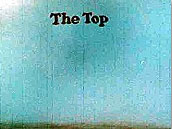
Via a plot synopsis from distributor Pathe Contemporary Films:
In The Top, a red fuzzy ceiling is made to represent “the top” – what people strive for and what they react to in a variety of ways.
The characters are at once funny and tragic. One man pays bricklayers to build a stairway up to the top; once up, he keeps the bricks to drop on people below. Other characters use the top simply to grab money from it and don’t seem to want to stay there.
There is no story here, only brief, incisive comments on the ways that people go after “the top”.
THE WILD CHASE (Warner Bros.) Friz Freleng, Hawley Pratt
Warner Bros. immediately had second thoughts after they ceased production of cartoon shorts towards the end of 1962. Producer DePatie and director Freleng had leased the abandoned space on the studio lot a year later to begin their own independent operation – and hit pay dirt with the Pink Panther shorts in 1964. Warner Bros. now found themselves still wanting new shorts – but this time contracting via an outside shop (DePatie-Freleng) at a lower cost. Warners could make due by reissuing classic Bugs Bunny cartoons, but felt they needed more with The Road Runner, Speedy Gonzales and Daffy Duck to build a library that could eventually sold to television. Freleng devised an idea to save further bucks by teaming Daffy and Speedy – so any one cartoon could be sold either as part of a Speedy package or to a Daffy series.
I suppose it was inevitable. Pairing the two super-fast characters in one cartoon was genius. Add the Coyote and Sylvester and it can’t miss – except it does. Big Time. What a disappointment. What a bore. Freleng wastes no opportunity to reuse animation from the old Chuck Jones cartoons. The whole thing is lazy – even the ending, which I assume should have had “The End” appear as fireworks in the sky (ala The Three Caballeros), just falls flat.
Want to appreciate what Freleng and crew could still do? Watch The Inspector cartoon above. Note in the documentation above that Assault And Peppered, a mediocre McKimson Speedy and Daffy cartoon, was submitted but withdrawn. The equally unworthy Wild Chase made it to the screening. I can only assume the Shorts Committee did what millions of moviegoers did when this came on screen at drive-in’s across the country – they went to the rest-room to take a leak.
WINNIE THE POOH AND THE HONEY TREE (Disney) Wolfgang Reitherman
Winnie the Pooh and the Honey Tree is the best of the Disney Winnie The Pooh featurettes, in my humble opinion. It set the stage for all future Disney Pooh shorts, series and features to come. Based on the first two chapters of the first book by A. A. Milne, this was a tasteful, gentle adaptation and – despite some stylistic artistic changes – quite faithful to the tone of the original stories.
I’m genuinely surprised this film wasn’t nominated – maybe it got lost in the shuffle, with such a large pool of nominees; maybe the shorts branch still felt some peer pressure to award the “dots” and “lines” of modern progressive animation… regardless, the second Pooh featuette would indeed be recognized a few years later – perhaps to make up for this oversight.
I don’t see the whole short online… but here’s a clip:
WOOF-WOOF (Zagreb Studio) Boris Kolar
In a year of personified dots and lines, this Zagreb short was worthy of recognition. Unfortunately it was not to be. Woof-Woof presents cats and dogs as abstract smudges, animated squiggles and doodles, in a simple (and still timely) plot that asks for unity despite our differences in looks and languages. Woof-Woof, indeed!
CARNIVAL – THE WORLD OF SINE (Specta Films) Jules Engel
Hungarian animator Jules Engel – of Fantasia and Bambi fame, later of UPA and Format Films – left Hollywood in 1962 for Paris, to paint and relax. Engel directed a few films during this period – one, an animated short, The World of Sine (aka Carnival), which was based on the print cartoons of Maurice Sinet. I have not seen it – only the clip below – but it looks pretty good. According to Wikipedia, the short was released throughout Europe by Jacques Tati!
Engel would return to Los Angeles in the late 60s – and by 1970 would found the Cal Arts Experimental Animation program, influencing animators for decades to come.
The earlier posts in this series: 1948, 1951, 1952, 1953, 1954, 1955, 1956, 1957, 1958, 1959, 1960, 1961, 1962, 1963 and 1964.
(Thanks to Libby Wertin at AMPAS, The Margaret Herrick Library)


 Jerry Beck is a writer, animation producer, college professor and author of more than 15 books on animation history. He is a former studio exec with Nickelodeon Movies and Disney, and has written for The Hollywood Reporter and Variety. He has curated cartoons for DVD and blu-ray compilations and has lent his expertise to dozens of bonus documentaries and audio commentaries on such. Beck is currently on the faculty of Cal Arts in Valencia, UCLA in Westwood and Woodbury University in Burbank – teaching animation history. More about Jerry Beck [
Jerry Beck is a writer, animation producer, college professor and author of more than 15 books on animation history. He is a former studio exec with Nickelodeon Movies and Disney, and has written for The Hollywood Reporter and Variety. He has curated cartoons for DVD and blu-ray compilations and has lent his expertise to dozens of bonus documentaries and audio commentaries on such. Beck is currently on the faculty of Cal Arts in Valencia, UCLA in Westwood and Woodbury University in Burbank – teaching animation history. More about Jerry Beck [



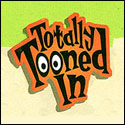



I do personally favor BLUSTERY DAY over THE HONEY TREE (ever so slightly though), but I equally don’t understand why Winnie the Pooh didn’t get nominated this year. Maybe they thought its wide distribution with THE UGLY DACHSHUND would qualify it for 1966 and possibly a second consideration? Actually there were more than enough preview screenings as early as October of ’65, so this is a lame possibility. (Then again, a few others considered this year were in release since 1963 and ’64, so there isn’t a lot of rhyme or reason.) I also wonder if it suffered some backlash from high brow critics at the time who didn’t consider it British enough. The gopher was an obvious Yank addition (since no gophers can be found in the U.K.), but even that character humorously says “I’m not in the book”. Christopher Robin’s voice artist Bruce Reitherman might have sounded too American in the first film as well. Echoes of the ALICE IN WONDERLAND “too Disneyfied” backlash almost a decade and a half before.
Yeah, I don’t know what they were thinking by submitting “The Wild Chase”. Granted, none of the cartoons that year were GREAT- 1965 was another subpar year for Warner Bros- but “Rushing Roulette” or “Suppressed Duck” would’ve been better choices.
Wow! So many submissions and only three nominees? This year’s submissions have a combined running time almost twice as long as those of the previous one. I wouldn’t blame them for not paying attention to some of the cartoons.
While The Dot and The Line took home the Oscar for Best Animated Short for 1965, there are two other Chuck Jones Tom and Jerry shorts that, in my humble opinion, should have been considered for nomination for the 1965 Oscar for Best Animated Short: Tom-ic Energy and Haunted Mouse.
And, over at Warner Bros, Paramount and Lantz these should of gotten some Oscar consideration as well:
It’s Nice to Have a Mouse Around the House (Warner Bros)
Corn on the Cop (Warner Bros)
Boulder Wham! (Warner Bros)
Whiz Quiz Kid (Paramount/Famous Studios)
Souix Me (Universal/WDP)
And for the record, that’s Paul Frees playing the two heads: “Weft” the Boris Badenov type voice, and the Politically-Correct “Wong”. Pat Harrington Jr protrayed “White” (the “American” – but more like a suave “English” voice) of the trio.
Later the Brothers Matzoreilys appeared in The Super Six but now Weft has a Irish Broque instead of a Russian Accent, Wright now as a nervous English accent, but Wong still remained the same with his Chinese accent. Both Paul Frees and Daws Butler did the voices in the Super Six version of The Brothers Matzoriley.
You can watch ALF, BILL & FRED here. It’s Bob Godfrey at his best:
https://vk.com/search?c%5Badult%5D=1&c%5Bq%5D=alf%20bill%20bob%20godfrey&c%5Bsection%5D=video&c%5Bsort%5D=2&z=video7794836_164945934
That just takes me to some kind of people finding site. Are you sure the address is correct?
Can you please check the address again? The link didn’t work.
Maybe try this link? You may need to be signed in to watch it. https://vk.com/video7794836_164945934
Yeah VK is basically a social media site like Facebook or Twitter, you have to sign up to see it if you want. Had I known, I would’ve helped Jerry on locating this film but I didn’t want to bring on the ire of Godfrey’s family since they’re pretty litigious on this sort of thing.
Surprised Warners tried to submit “Assault And Peppered”. Not surprised that it got “withdrawn”.
As for “The Wild Chase”, I recommend watching it with Paul Dini’s audio commentary on the “Looney Tunes Golden Coleection: Volume 4” set. I think he pretty much summed up everyone’s’ opinion on that short.
I’m disappointed that the Academy didn’t submit “Honey Tree”. Interestingly, I had the same theories as JLewis on why it might not have nominated. Fortunately, the Academy made up for it (in a big way) a few years later.
What I’m very surprised is that Lantz didn’t submit “Half-Baked Alaska” for a nomination. That was one of their last good cartunes (I have a sort spot for Marcus’ shorts).
I remember “Alf, Bill, and Fred” was available on youtube for a short while. All I can say is it was very good. Wish you were there.
Yeah I think that might’ve been Bob’s family who put it up initially (or at Vimeo). I think they got cold feet at people freely sharing this films around the net.
With such a diverse set of submissions, I’m surprised there were no more than 3 nominations that made the cut. Personally, I find it a shame LE NEZ and HONEY TREE were snubbed (the former because I find the unusual pinscreen technique absolutely breathtaking and worthy of recognition while the latter largely due to nostalgia and charm)
ALF, BILL AND FRED is certainly worth seeking out. Oscar-worthy? Probably not, but it’s so delightfully silly it’s hard for me not to consider it as one of Bob Godfrey’s best.
For 1960’s, I think “The Rise and Fall of Emily Sprod” and maybe “Two Off the Cuff” are also worth a look (as well as “The Do-It-Yourself Cartoon Kit”).
The Dot and the Line was Jones’ last hurrah. However, his ’60s cartoons were still better than what Hanna-Barbera and Filmation were churning out.
I believe “How to Live with a Neurotic Dog” was based on Stephen Bakers book of the same name. I haven’t read it in years but after watching the cartoon it seemed awfully familiar. I didn’t see it mentioned in the credits, but the original edition had illustrations by the great Eric Gurney (another former Disney animator and author and illustrator of the equally funny “How to Live with a Calculating Cat”)
Regarding the DPF Inspector cartoons,was the Inspector meant to be Clouseau? He was never referred to as Clouseau in the cartoons. Couldn’t DPF use Clouseau’s name from Blake Edwards or the MIrsch Corporation?
I remember both The Inspector AND Clouseau appearing in the 90s PInk Panther cartoon series.
I asked David DePatie about this, and he said that, for copyright purposes, Inspector Clouseau and the cartoon Inspector are considered to be two different characters, something Blake Edwards requested, although he didn’t elaborate why he wanted it that way.
There exists an unproduced “Inspector” storyboard where the main character is referred to as Clouseau, with the Commissioner explicitly called “Dreyfus”.
Thanks for the reply & info.
Am a bit curious why no Pink Panther shorts were considered following THE PINK PHINK’s big win. Was the Inspector enough? I understand that 1965’s crop was decidedly hit and miss, since they were still trying to figure out what worked best with this new super star. What was distinctive of the early entries was a curious emphasis on dialogue and narration, unlike the later films that focused just on music and sound effects (since panther pantomime worked best). Obviously giving him a voice in PINK ICE and fleetingly in SINK PINK was a bit of a No-No, even if the Rex Harrison imitation was quite unique. Yet supporting characters doing all of the talking FOR the panther did make for some belly laugh entries: Paul Frees’ Texas game hunter trying to lure victims for his trophy room with a self-made ark in SINK PINK and Mel Blanc’s drunk in PICKLED PINK are my personal favorites of this year.
and for some reasons, “Assult and Peppered” was crossed off as “withdrawn”, Daffy and Speedy Cartoons was the worst Looney Tunes Cartoon ever made in the 60’s. I Hate them so much!
Also check out Mogugub’s THE POP SHOW with a young Gloria Steinem if you like ENTER HAMLET
The Top in it’s entirety: https://archive.org/details/thetop_20170601
I rather suspect that “The Itch” was influenced by Mervyn Peake’s 1953 novel MR. PYE. That is also about an Englishman who, to his embarrassment, sprouts wings.
Something on the pin animation progress: https://blog.nfb.ca/blog/2018/07/25/animation-techniques-pinscreen/
A CHILD’S INTRODUCTION TO THE COSOMOS can be seen here: https://www.youtube.com/watch?v=uIOjU4PxVnE